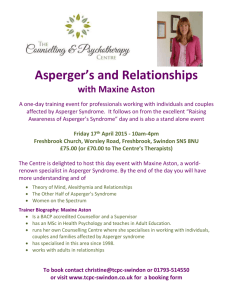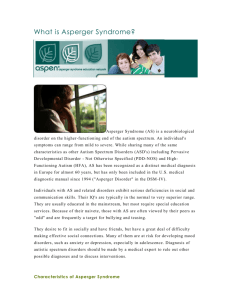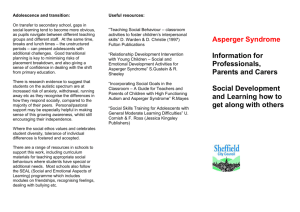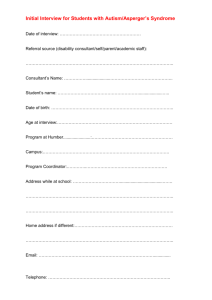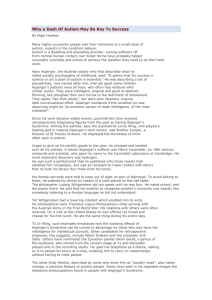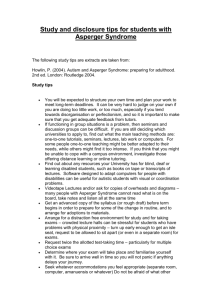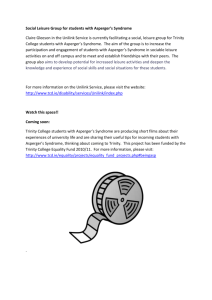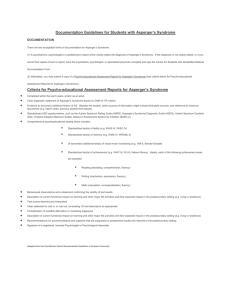Language and Metamorphosis Supervising Computer Science Students diagnosed with Asperger Syndrome Abstract
advertisement
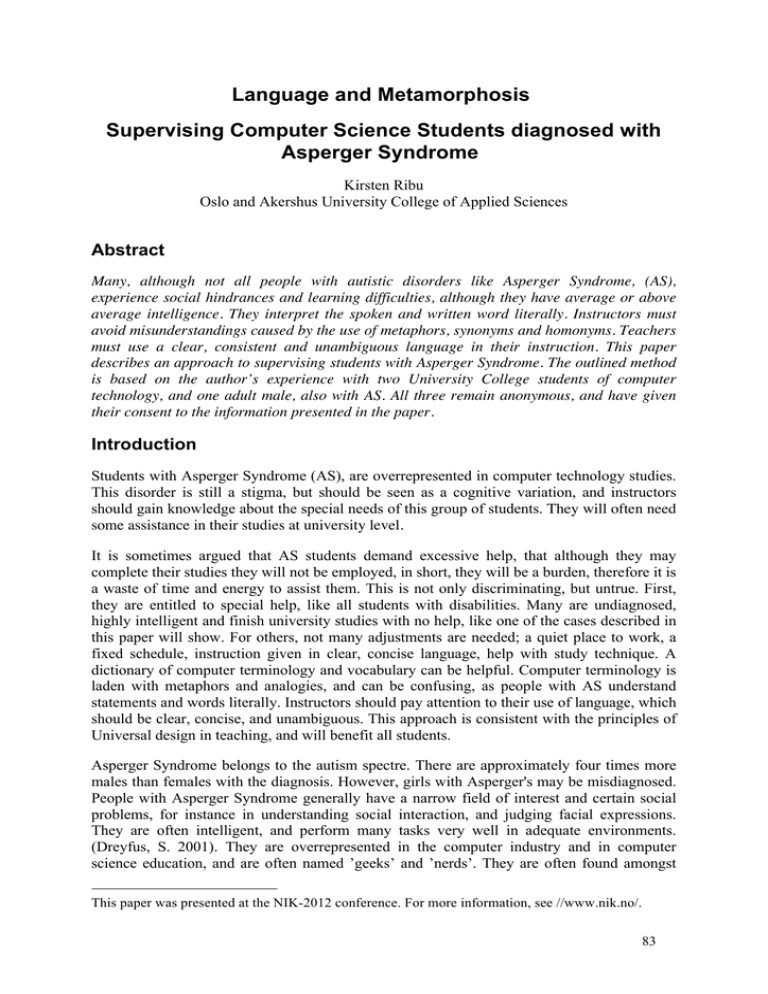
Language and Metamorphosis Supervising Computer Science Students diagnosed with Asperger Syndrome Kirsten Ribu Oslo and Akershus University College of Applied Sciences Abstract Many, although not all people with autistic disorders like Asperger Syndrome, (AS), experience social hindrances and learning difficulties, although they have average or above average intelligence. They interpret the spoken and written word literally. Instructors must avoid misunderstandings caused by the use of metaphors, synonyms and homonyms. Teachers must use a clear, consistent and unambiguous language in their instruction. This paper describes an approach to supervising students with Asperger Syndrome. The outlined method is based on the author’s experience with two University College students of computer technology, and one adult male, also with AS. All three remain anonymous, and have given their consent to the information presented in the paper. Introduction Students with Asperger Syndrome (AS), are overrepresented in computer technology studies. This disorder is still a stigma, but should be seen as a cognitive variation, and instructors should gain knowledge about the special needs of this group of students. They will often need some assistance in their studies at university level. It is sometimes argued that AS students demand excessive help, that although they may complete their studies they will not be employed, in short, they will be a burden, therefore it is a waste of time and energy to assist them. This is not only discriminating, but untrue. First, they are entitled to special help, like all students with disabilities. Many are undiagnosed, highly intelligent and finish university studies with no help, like one of the cases described in this paper will show. For others, not many adjustments are needed; a quiet place to work, a fixed schedule, instruction given in clear, concise language, help with study technique. A dictionary of computer terminology and vocabulary can be helpful. Computer terminology is laden with metaphors and analogies, and can be confusing, as people with AS understand statements and words literally. Instructors should pay attention to their use of language, which should be clear, concise, and unambiguous. This approach is consistent with the principles of Universal design in teaching, and will benefit all students. Asperger Syndrome belongs to the autism spectre. There are approximately four times more males than females with the diagnosis. However, girls with Asperger's may be misdiagnosed. People with Asperger Syndrome generally have a narrow field of interest and certain social problems, for instance in understanding social interaction, and judging facial expressions. They are often intelligent, and perform many tasks very well in adequate environments. (Dreyfus, S. 2001). They are overrepresented in the computer industry and in computer science education, and are often named ’geeks’ and ’nerds’. They are often found amongst This paper was presented at the NIK-2012 conference. For more information, see //www.nik.no/. 83 artists and scientists. They are sometimes extremely talented, and reach the hight of genius in their field. (Grandin, T. 2001). However, these are special cases. The concern of this paper is students at University level. The cases described here are based on my personal experience with three males who have all been diagnosed with Asperger’s Syndrome at the ages of 15, 28 and 46. Two were University college students, and one is a successful employee in management. Background Dr. Hans Asperger, an Austrian paediatrician, originally described the syndrome in 1944. The syndrome is now classified as an autistic spectrum disorder. Autism is associated with abnormal social communication and unusual obsessional interests and repetitive behavior. Asperger Syndrome affects somewhere around 7.1 per 1000 people. (Ehlers & Gillberg,1993). Autism was once considered a very rare disorder, occurring in one out of every 10,000 births. The increase is most likely due to better diagnostical methods. Little is known about the causes of autism. What is known is that the computer industry and computer science studies attract people with AS. Students that are called ‘nerds’ or ‘geeks’ may have Asperger Syndrome. (Klawe, M. 2001). It has been called the “engineer‘s disorder” (Silberman, S. 2001). For the lecturer and supervisor, it is important to have knowledge about autism and to make adjustments for the special needs of these students. Aspergers have problems with teamwork, social interactions and collaboration, and oral presentation. Because of their focus on details and their understanding of cause and effect, people with AS can be good problem solvers. Several IT companies in Europe are now recognizing their special skills especially as software testers because of their unique ability to identify errors in program code. In Norway, the IT company Unicus employs only people with AS and computer skills. Asperger Syndrome and the Metaphor Problem E. Dijsktra, legendary professor of Computer Science and father of the Shortest Path algorithm, writes in his note ”On anthropomorphism in science” that (.....) ”anthropomorphic thinking is no good in the sense that it does not help. But is it also bad? Yes, it is, because even if we can point to some analogy between Man and Thing, the analogy is always negligible in comparison to the differences, and as soon as we allow ourselves to be seduced by the analogy to describe the Thing in anthropomorphic terminology, we immediately lose our control over which human connotations we drag into the picture. And as most of those are totally inadequate, the anthropomorphism becomes more misleading than helpful.” (Dijkstra, 1985). Dijkstra’s idea is that computer science comes with a vast array of metaphors to help beginners and experts think about what it is that they are doing. Dijkstra claims that these metaphors are misguided and are damaging to the profession. This is an interesting point of view. Antropomorhic metaphors are very confusing for people with AS, because of identifying human behaviour in connection with computer programs. Since human behaviour is often not understood, comparing computer programs with humans can be very misleading. Dijkstra mentions saying ’take this guy talking to that guy’, when meaning nodes in a network, and criticizes this way of explaining the technology. Also, he dislikes the metaphor ”bug” in a program. In actual fact it is an error. By calling the error a ”bug” the responsibility for the error is shifted from the programmer who induced it, to the 84 program itself. Dijsktra proposed to rid computer terminology of such infantile metaphors, for more precision and professionality. It is worth considering his point of view. Some teachers compose their own compendiums and create terminology and explanations that differ from official terminology, thinking it offers better explanations. This can be harmful, and there have been cases where the practice has been criticized and abolished by NOKUT – the National Organ for Quality in Education. Also it is interesting to note that AS students often are the ones to point out that they do not understand certain words or phrases, thinking this is due to their Asperger mind. It often turns out that many other students also do not understand. Three cases of Asperger Syndrome I have supervised two bachelor students with AS in computer technology, each over a period of one semester. Supervising these students is a little different than supervising neurotypical students. It is rewarding and interesting. Aspergers are always truthful, and usually easy to get on with. There is no small talk, they are punctual, appointments are always kept, and work is conscentiously done when it is demanded of them. When left to themselves they are often lost, they may turn day into night, so a good structure around their daily life is necessary. I have also interviewed an adult with AS aged 49, who has lately been diagnosed. He has been successful in life, and is an example of how many people with AS learn to cope with their social problems. He has valuable observations of what may be helpful for students with AS. O. Age 28 years old. Student of computer technology. O. was diagnosed with AS at the age of 15. His problems had started around the age of 12. Before that he had many friends, did fairly well in school, and did not experience that he was in any way different from others. Later, when he realized that he did not understand what was going on socially, his friends would explain, and he copied their behaviour. After being diagnosed he received help and assistance in school, and was admitted to a University on a computer technology programme. He attended school every day, went to lectures and seminars, worked diligently and was very lonely. Nobody spoke to him. He is different, and is perceived as strange. He does not talk much, when he does he talks in a loud voice, and about his special interests. He is very good at drawing. He makes beautiful and complicated pencil drawings where he starts with the details, and works it all into a well composed drawing. O. comes and leaves without saying hello or goodbye. He is not easily included in a group, although he has friends he has known from childhood it is difficult to make new friends. O. took a few exams, became depressed, was diagnosed with deep depression, received psychological treatment and finally gave up and left University, telling no one. No one missed him. After a few years, backed by his family, he went back and continued his studies. This time the University realized its responsibility and offered help in the form of extra supervision, and arranged for an assistant paid by NAV, The Norwegian Labour and Welfare Administration. The assistant, a student of computer technology; met regularly with O, and they worked on assignments together. O. got through the curriculum and completed all the compulsory courses on the programme on time. He then had only the final project left to achieve his Bachelor degree in IT. Normally, the bachelor students work in groups on their projects, but this may prove difficult for a student with AS, although they can work well in pairs. But is may be difficult to find a suitable partner. The AS student does not normally 85 have many friends among his or her peers, and because of the lack of social skills are often seen as being different, strange, non- communicative, and difficult to co-operate with. However, O. does have several friends in private with whom he meets regularly, travels abroad and goes on outings, so if things had been arranged a little earlier is would probably have been possible to find a working partner. However, as all the students already had established their project groups, it was formally arranged for O. to do his project on his own, with the help of his assistant. In order to plan his work and find out about his personal needs I conducted an informal and open-ended interview with follow up questions at the beginning of the project period in the spring semester. This form of interview was chosen as it was perceived to be the best way to find out as much as possible, without limiting answers to a structured interview guide. As this was a pedagogical issue, the practical aspect was important. The interview revealed information on O.’s preferences, interest and things that might upset or disturb him. He explained how he had taught himself social skills, describing how he had studied this “ in the same way that other people study mathematics”. He observed that during our conversation, he had read all the titles of the crammed bookshelves. This was very tiring for him, so the interview was limited to half an hour as that was his limit for being able to concentrate. O. understands everything literally. For instance, if asked: “Do you know what time it is?” he will say “yes”. This is a typical syndrome symptom. In order to get a proper answer one must ask: “What time is it?” Communication must be direct, with consistent language, and clear meaning. Surroundings should be quiet and ideally without disturbing visual artifacts like pictures or books. The project work he decided on for his bachelor work was a programming task, designing a networking game for an instructor in computer networks to be used for students on the master level. A quiet place was found for him to work, and he came regularly and sat quietly programming. The written report was completed with a little help. O is good as describing, so the user manual accompanying the program was very clear. Normally, students present their work for sensor, teachers and fellow students in an auditorium. Since this presented a problem, O presented his work for the sensor in my office. He passed his exam and is now employed in a software company as a tester. J. 26 Years old. Student of Computer Technology J is bright, tall and handsome, has a girl friend and drives a motorcycle. He has a job as a night watch. He is socially very capable, has many friends. He does not have an Asperger look. At school he did well, worked hard, and was admitted to University. J. was recently diagnosed with Aspergers Syndrome, and feels it is a stigma. Up to now, he has been characterized as having learning difficulties, and being unable to co-ordinate the two halves of his brain. This is no diagnosis, and he has received no help at school or university. He completed all university courses on time, and finished his bachelor project in 2011. He worked in a group, but felt like an outsider. Although he may act very social, he does find it difficult to participate in larger groups. His self-esteem is low. He compares himself to others and feels very different. He hides the diagnosis from his girl friend. He reports many misunderstandings and quarrels with her. She knows about his learning difficulties, and means the solution is to read more. Reading is one of his main difficulties, he reads very slowly, and he experiences a sense of failure when trying to understand what he reads. J. failed one subject three times. He was allowed a fourth try. He had been trying to understand data modeling. It soon became clear that he understood very little. The exam 86 situation became frightening, he explained that he could not control his brain, everything became very confusing and eventually impossible, and he walked out of the examination room. When he was finally diagnosed he could apply for an oral exam. This was accepted, and it was crucial to find out where his difficulties lay. The terminology was confusing. He had trouble reading the text-book, he read without understanding many of the words. When he asked for an explanation, the teacher spoke in a louder voice, saying the same things, he felt stupid, and dared not ask again. It was arranged for J. to have fellow student assist him, together they worked on tasks and former examinations. I met J twice a week, went through his work and gave him tasks to solve. We agreed that he should read a certain number of paragraphs, write down all the words he did not understand, and look them up. I would explain the words he still did not understand. A different teacher agreed to give him a few lessons. When things were explained differently, in quiet environments, with no stress and by a person who knew about his problems, J. had no trouble understanding. After two lessons he was quite confident. We continued our meetings, J. took his exam and got a B. He was euphoric. So were his parents. J. is now much more confident, and is now applying for jobs in IT companies. E. 49 years old. Employed in management. E. is married, has three children, is well-educated in IT and business, and has had a long and successful career. He works in management, for large companies. He was diagnosed with Asperger Syndrome about three years ago. I conducted three informal, semi-structured interviews with E. E. appears perfectly normal, though a little shy. He is not open about the diagnosis, he wants to be like everybody else. After a while during the interview it becomes clear that he is not. The first interview was in reality a conversation in order to get to know the Asperger part of him. When he relaxes, he is more himself, and the typical syndrome symptoms become more apparent. He talks in a louder voice and sticks to one subject for a long time. Even when asked a new question he may go on about the same subject. He has very strong views on the topic of AS, and states his mind forcefully. Outwardly, E. is a success. He has learned social skills by copying the behaviour of others. He has learnt to use cognitive training in order to distract himself from anxiety, compulsive thinking and repetitive behaviour. When he was in his early twenties he had panic attacks. After that he was deeply depressed for several years. When asked if he had received therapy, he answered in the negative, he had understood that something was wrong, that he was different from other people, he had realized that he had a neurological disorder, and had taught himself to behave like the neurotypical. In the years with depression and anxiety he went to work every day, he used his cognitive abilities to calm himself by telling himself that panic is not deadly. He was never on sick leave. He also used to run hard in order to control the panic. E. has never felt he belonged to a group, he is unable to do small talk, and can not handle joviality. His parents-in-law did not like him in the beginning. He may talk in a loud voice, laying down the law, not realizing when others have changed the subject. He may keep coming back to the same subject. Change of plans make him angry. He can become aggressive if he is not listened to. Rigidity, anger, anxiety, and a sense of righteousness are 87 typical of Asperger Syndrome. He understands now that other people are not like him, that it is his behaviour that may seem strange to others. He also sees that he was formerly not well liked, that he said strange things, or spoke in a strange way. Eye contact is painful, but he has taught himself to meet the gaze of others. After being diagnosed he was even more intent on appearing ‘normal’. However, he also feels that in the process he is losing his real self, he is becoming emotionally ‘flat’, which is a little sad. On the other hand he experiences more control over his life. He reports that most Aspergers who are married get divorced, so it is a small miracle that his marriage lasts. E. studied IT and business at University level for two years, and later completed advanced courses in management at the age of 37. At that stage he had more experience and could reason more easily, he had background knowledge to build on. He reports that reading is difficult. He must be very interested in the subject to be able to concentrate. The text should be broken into smaller parts, because he has problems finding the important parts in a long text. The text should also be well structured. Tables and bullet points are nice features. Language in text-books should be straightforward and unambiguous. Because everything is understood literally, E. suggests that a table of words that have two meanings, both an ordinary and a technical meaning, can be very useful. Today E. understands and knows much about himself, he has acknowledged who he is, he has a lot of work experience and lives a family life. He knows which situations may become difficult, so he controls them or avoids them. At work he is diligent, honest, and straightforward. He speaks his mind, something which is not always popular. He is analytical, good at strategic thinking, and has a talent for structure and detail. E. thinks he could be a good leader, but that his social problems are a hindrance, and that he is not desired as a leader. He would like to help young people with Asperger Syndrome and share his experiences, to help others gain more self-confidence by showing how it is possible to work one’s way out of many problems, to study, get interesting work, to have a career and relationships. Asperger Syndrome and Language Pitfalls Many Aspergers speak loudly and continuously, or say little or nothing at all. As an instructor it is difficult to know if someone is actually listening, or whether what is being said is understood. Some Aspergers have a great sense of humor, love to play with words, and are easy to talk to. However, they can be a disaster when it comes to jokes. E. reports that his wife forbids him to tell jokes at parties. No one but he seems to get the point and the situation becomes embarrassing. Every-day language can be confusing to people with AS. Natural speech is not precise, and can be full of satire, jokes, metaphors and understatements. Also, computer technology is laden with metaphores. AS people understand what is said literally. Synonyms can present a problem. Other difficulties are homophones, words that sound alike but have different meanings, and homonyms- words that are spelled differently but sound the same and have different meaning. Instructors should become conscious of the language they use. It should be clear and unambiguous. 88 Computer terms Computer science uses words and terms from other diciplines. Words like design, implementation, architecture and prototyping are used quite differently than the original definitions. A list of such words with their different meanings is useful. Homophones and homonyms Homophones are words that sound the same, but have different meanings, and homonyms are words that are spelt the same and sound the same, but have different meanings. Sometimes these are confused. Examples of homophones: accessary, accessory - ad, add - allowed, aloud - arc, ark - weather, whether- while, wile - whirled, world. Homonyms are often ordinary every-day words often used. They can have several meanings. Take for instance the word ‘break’. An example that presented a huge problem for one student emerged in database context: Breaking the rules of normalization, and breaking the table into smaller tables. Here the word ”break” has two different meanings within the same context. The student understood it as having only one meaning, which made the theory of normalization impossible to understand. In this text it is explained how to get from 1st normal form to 2nd normal form: ”You can achieve Second Normal Form by breaking (the table) into two tables. The process of breaking a non-normalized table into its normalized parts is called decomposition. If the table has a composite primary key, then the decomposition should, in general, be guided by breaking the key apart and putting all columns pertaining to each component of the primary key in their own tables. (….) Sometimes it is necessary to break the rules of normalization and create a database that is deliberately less normal than it otherwise could be. ” In this example both the table and the key are broken, and then the rules are broken. When the word ”break” is understood literally and as having the same meaning in all these three sentences, the result is very confusing. This is what the student experienced. After the different meanings of the word ”break” were cleared up, understanding normalization became easy. Imprecise language An example of bad grammar was found in the following text taken from an assignment: ‘Construct an array of integers between 0 and 20. Print a list of the results, not including the numbers.’ This was confusing to many students in the class. The text was probably meant to read ‘do not include the numbers 0 and 20 in the list’. The student who finally asked what this meant was a girl with AS, she was convinced that because of her Asperger mind she did not grasp the meaning. These examples demonstrate serious problems with language, both every-day and text-book terminology. Instructors should become aware of the language and the words they use in their presentations and texts, and try to be as consistent and as precise as possible. A good practice it to use few words, a good structure, avoid metaphors, and define and explain all terminology. 89 Metamorphosis. From Problem to Good Practices The University in Leeds has a good practice for helping students with disabilities. The following guidelines are adapted from the basic guidelines for assisting students with Asperger syndrome found on the Leeds web-site, and expanded on. Points especially concerning supervision and language issues have been added to the original guidelines. General adjustments • • • • • • Appoint a main supervisor who has training and experience in supervising AS students. Identify a quiet place for retreat - students with AS often find noisy environments overwhelming. This can lead to anxiety. Identify where the student can go for help with course-related issues. The best solution is through the supervisor, who communicates with the course instructors. Ensure that instructions and deadlines are very clear, and assignment briefs are specific. Establish a clear line of communication to inform the student of changes in routine (e.g. room changes, change of time for appointments). Arrange for oral examinations to be held instead of written. Instruct the examinator about AS. If possible, the supervisor can be present during the examination, if this will make the student feel more secure. Learning & teaching adjustments • • • • • • • • The supervisor can help to structure work. Encourage students to write down things that are not understood, and explain all unknown words. Encourage reading text in small portions. Help to identify what is most important to read and understand first. Give specific tasks to solve, correct and give feedback. Different teachers explain the same thing in a different way. Ask a colleague to explain if things are not understood after many attempts. Use (compose) a dictionary of homophones and homonyms. Explain metaphors, use concrete every day words. Consider granting the student permission to work alone rather than in a group. If group work is essential, working in pairs is a good choice. Arrange frequent meetings with supervisor, ideally at the same time and place each time, for instance once a week. Sometimes it is sufficient to sit quietly and work. Avoid assessing by oral presentation if this is unnecessary, or arrange for oral presentation privately. Conclusion and Future Work People with Asperger Syndrome are often labeled ‘geeks’ and ‘nerds’. The computer industry needs their skills, and it is arrogant not to acknowledge that they can make valuable contributions. Aspergers are good at testing and finding faults in software code, and their special skills should be made use of. The IT company Unicus focuses on the positive aspects of autism, appreciates the special skills of Aspergers and hire them as test consultants to software companies. 90 Asperger Syndrome must be accepted and understood by teachers and peers, in the same way that dyslexia has become accepted and understood. People with AS are not stupid, or ignorant, but different. They need a little help and some practical adjustments in order to function in what is perceived as the chaotic and noisy surroundings of the University. They should have specially appointed supervisors who have knowledge about autism, and can give the appropriate assistance. There is no evidence of empirical studies showing that university or college teachers in general receive any training in understanding hidden disorders. Unqualified teachers may in some cases be given the task of ’taking care of’ students with special needs. In O.’s case, the job was given to a teacher who had no qualifications for this sort of work, being neither a teacher in special pedagogics or an expert in computer science. O. finally disappeared after a while. Training teachers in understanding diverse disorders must be taken seriously. Instructors who help AS students should also have advisors, and be given the opportunity to attend courses to educate themselves. Practical tools like the dictionaries outlined in this paper should be made in co-operation with linguists. Following up students who have finished their studies can show what happens to them after studies, and their stories may serve as examples to others. Asperger students should have mentors in the institution, for instance an older student, so that they are not left to themselves, and if they wish meet with adult Aspergers who have succeeded in studies and have jobs and careers. References Attwood, T. (1998) ’Asperger Syndrome: A guide for parents and professionals.’ London: Jessica Kingsley Publishers Ltd. Dijkstra, E. ‘Talk at The Philosophers' Lunch, 25 September 1985. http://www.cs.utexas.edu/~EWD/transcriptions/EWD09xx/EWD936.htm Dreyfus, S. (2001) ’Underground: Tales of hacking, madness and obsession on the electronic frontier.’ http://www.gutenberg.org/etext/4686 Last accessed 24th July 2012. Egan, M. A, (2005) ’Students with Asperger Syndrome in the CS classroom’ ACM SIGCSE Bulletin archive Volume 37 , Issue 1 Pages: 27 - 30 ISSN:0097-8418 Ehlers, S., & Gillberg, C. (1993) The epidemiology of Asperger Syndrome: ’A total population study’. Journal of Child Psychology and Psychiatry 34(8): 1327-1350. Grandin, T. (2001) Genius may be an abnormality: Educating students with Asperger’s Syndrome, or High Functioning Autism. Web site: http://www.autism.org/temple/genius.htm Last accessed 24th July 2012. Klawe, M. (2001) Refreshing the nerds. Communications of the ACM, 44(7): 67-68. Journal of the Sociological Association of Aotearoa/New Zealand Volume 24 Number 2 2009 Web site: The Geek syndrome. Silberman, S. http://www.wired.com/wired/archive/9.12/aspergers_pr.html Last accessed 24th September 2012. Web site: Tony Attwood ’What is Aspergers?’ http://www.tonyattwood.com.au/index.php?option=com_content&view=article&id=62 &Itemid=176) Last accessed 24th July 2012. 91 Web site: The university of Leeds http://www.equality.leeds.ac.uk/for-staff/goodpracticeguidance/teaching-and-supporting-students-with-asperger-syndrome/ Last accessed 24th July 2012. Web site http://unicus.no/ Last accessed 24th September 2012. 92
